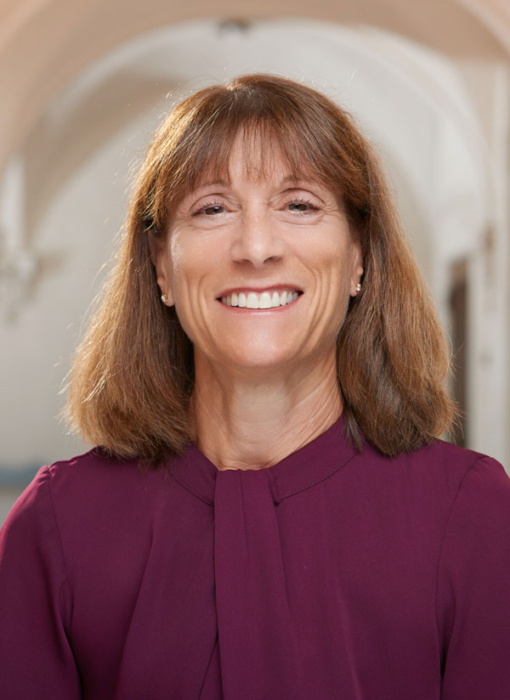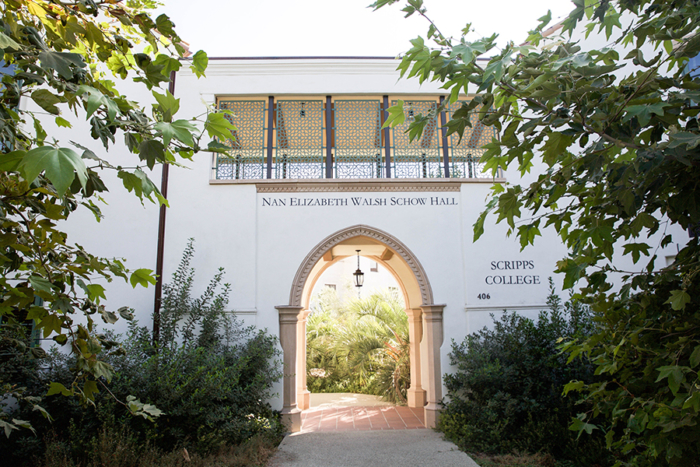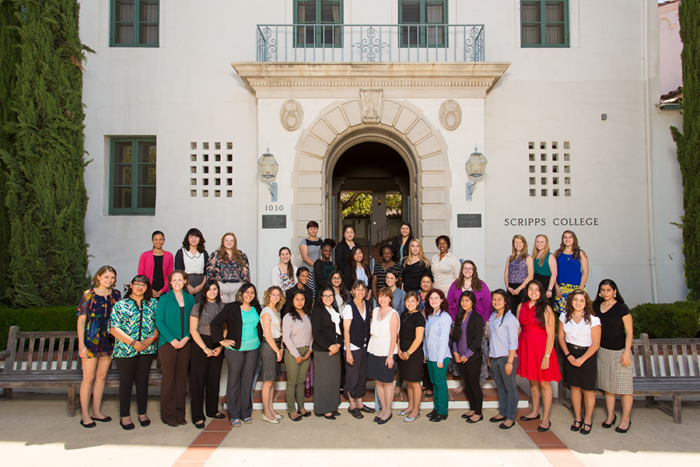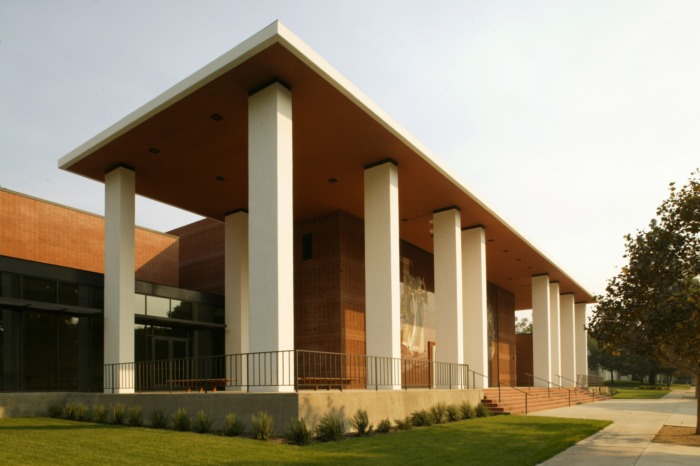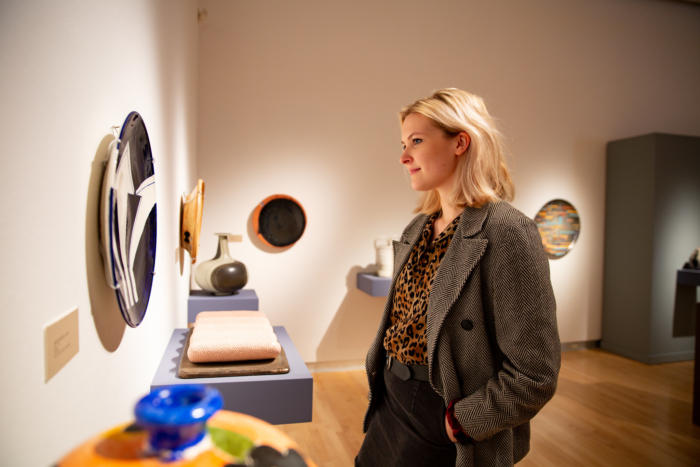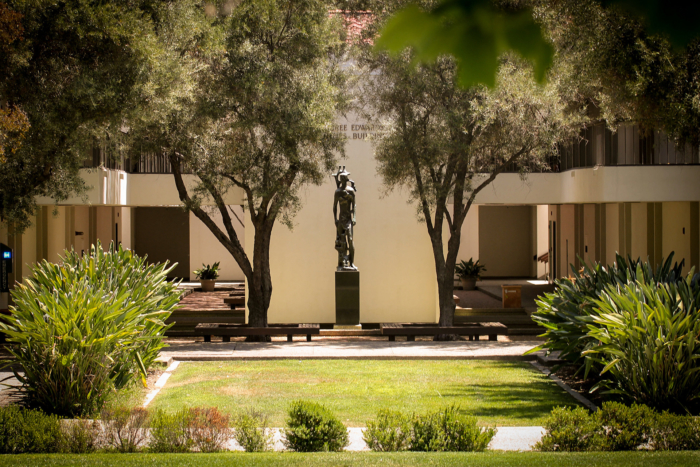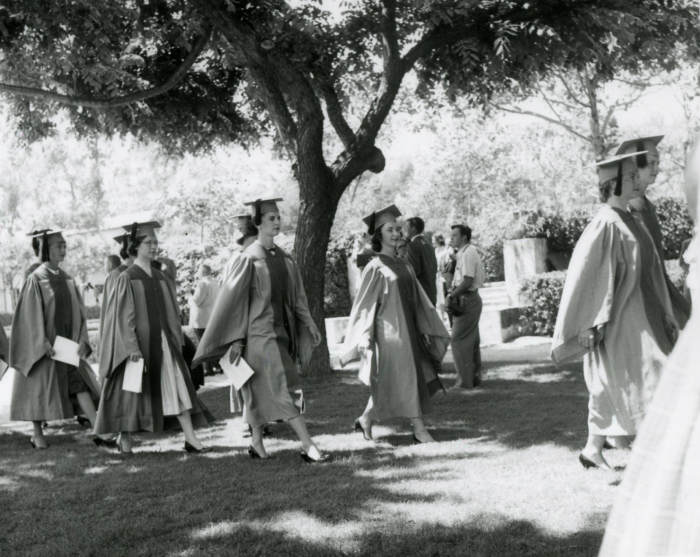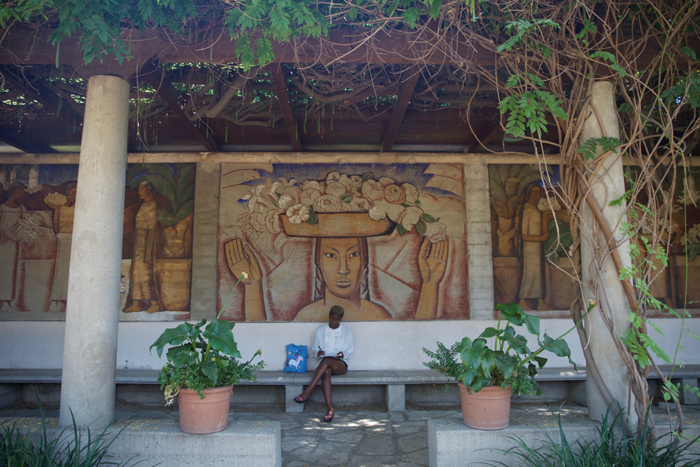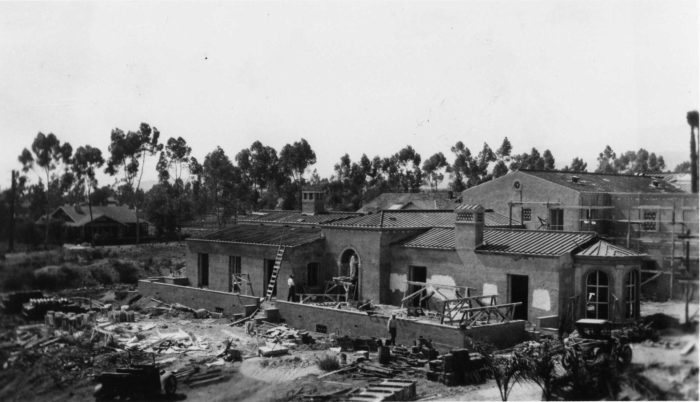Scripps Timeline

2022
Scripps and Pitzer Colleges celebrate the groundbreaking of the new science center on May 13. On July 1, Suzanne Keen begins her term as the 10th president of Scripps College.
2021
Scripps’ ninth president, Lara Tiedens, resigns effective April 15. After 18 months of remote instruction due to the COVID-19 pandemic, students return to campus for the fall academic semester.
2020
A variety of sustainability efforts were implemented, including: solar panel installation on the Lang Arts building roof, the addition of smart meters on every building, LED retrofits in all residence halls’ browsing rooms, and upgrading life-cycled boilers with low-emission replacements. The College celebrated the 50th anniversaries of Chicano Latino Student Affairs..Read More
2019
A new rose garden was dedicated in the South Balch Courtyard to honor the life and contributions of alumna and Life Trustee Gabrielle Jungels-Winkler ’72.
2018
The College’s new strategic plan, the Scripps Centennial Plan, is developed. The campaign for Scripps College: More Scripps is the most successful campaign in Scripps’ history, raising $179M.
2017
The College embarks on a strategic planning process initiated by President Tiedens, advancing four themes: Inclusive Student Success, Mission-Driven Outreach, Distinctive Identity, and Innovative Learning Organization.
2016
Lara Tiedens is appointed the College’s 9th president by a unanimous vote of the Board of Trustees. Scripps’ tenth residence hall, NEW Hall, opens to new and returning students.
2014
The Katharine Howard Miller ’55 Wing of the Bette Cree Edwards ’49 Humanities Building opens during the summer break.
2013
Launch of the College’s largest ever campaign We Want More: The Campaign for Scripps College. At $175 million, We Want More strives to further academic excellence, national leadership, signature campus and financial strength. It was fueled by the collected power of the Scripps Community. Scripps awards the Ellen Browning Scripps..Read More
2011
The “Nellie” Scholarship, established in honor of Ellen Clark Revelle ’31, is made available for continuing students. The College actively participates in “Pacific Standard Time: Art in L.A. 1945-1980,” a collaboration of more than 60 cultural institutions in Southern California. The Joint Science Department becomes the W.M. Keck Science Department..Read More
2010
Scripps College Academy receives National Arts and Humanities Youth Program Award, the highest recognition given to youth programs, in a White House ceremony. Elizabeth Turk ’83 wins MacArthur “Genius” Award.
2009
Lori Bettison-Varga is appointed eighth president of Scripps College. She and her family move into the Revelle House, the first president to live on campus since John H. Chandler.
2007
Scripps’ sixth president, Nancy Y Bekavac, announces her resignation, effective July 1, 2007. Frederick “Fritz” Weis” is appointed interim president and is named full president in 2009. An anonymous donor makes a $10 million gift to the College to support faculty initiatives on behalf of the Board of Trustees. This..Read More
2006
Sallie Tiernan Field House, a state-of-the-art recreational and athletic facility to be located next to the swimming pool on the east side of campus. The Board of Trustees approves the strategic plan, “Scripps College in the Next Decade: Leading with Excellence,” which focuses on academic excellence and women’s leadership.
2004
The most ambitious fundraising campaign in Scripps history surpasses its original $85 million goal with gifts and pledges totaling over $101 million. Over 87% of Scripps alumnae contributed to the Campaign for the Scripps Woman, which began its public phase in 1999 and concluded June 30, 2004. Scripps College Landscape..Read More
2003
The Performing Arts Center, an expansion of Garrison Theater, opens. Music practice rooms and classrooms, faculty offices, the Nancy Hart Glanville Music Library, and the MaryLou and George Boone Recital Hall are added. The new center becomes the permanent home for The Claremont Colleges Joint Music Program, consisting of Scripps,..Read More
2002
Scripps celebrates its 75th Anniversary with yearlong events: the Bradford Blaine Faculty Lecture Series; a Distinguished Speaker Series that includes Dr. Susan Love, financial guru Susie Orman, renowned author Sandra Cisneros, political commentator Molly Ivins, and pioneering architect Norma Sklarek; and the Gabrielle Jungels-Winkler Inaugural Lecture featuring former President of..Read More
2001
The Ellen Browning Scripps Reading Room is added to Denison Library. The room was an existing space redone to house collected papers, books, and personal letters of the College’s founder. The new Scripps Pool is completed and opens, phase one of a three-phase transformation of east campus, which will eventually house the Sallie..Read More
2000
Gabrielle Jungels-Winkler Hall opens to students. Named for alumna Gabrielle Jungels-Winkler ’72, who provided key guidance to architects on this project in addition to supporting student scholarship programs, an endowed faculty chair in contemporary European studies, a lecture series at the European Union Center of California, as well as other..Read More
1994
Quotes of famous women in the arts, letters, and sciences are chosen by a committee of students, faculty, and alumnae to line “Inscription Walk,” a pathway connecting the W.M. Keck Science Center to Scripps’ east side of campus. The walk features quotes by scientists Maxine Singer, Rachel Carson, Maria Mitchell..Read More
1992
The W.M. Keck Science Department moves from its previous home in Steele Hall and the neighboring buildings. A two year renovation begins to develop a dedicated Scripps art center, and provide a permanent home for Scripps Information Technology Services and other administrative needs.
1990
Nancy Y. Bekavac, graduate of Swarthmore College and Yale Law School, begins her term as Scripps College president, becoming the first woman fully appointed to this position.
1984
Buildings and gardens at the center of Scripps campus are selected for inclusion in the National Register of Historic Places.
1976
John H. Chandler is appointed president of Scripps College, serving until 1989. The Southern California Intercollegiate Athletic Conference begins sponsorship of women’s sports. The existing Claremont Men’s College/Harvey Mudd competitive athletics program expands to include students from Scripps. The new program, CMS, chooses the team names the Athenas (women’s teams)..Read More
1975
In spring, Scripps’ student-run campus coffeehouse, The Motley to the View, opens its doors for business. Over the years, the Motley has changed venues from Balch Hall to the basement of Old Lang to the Frankel-Routt complex, and finally to its current location in Malott Commons.
1972
Scripps honors its first president, Ernest J. Jaqua, by renaming the central grassed area Jaqua Court and Quadrangle. The primary green remains a gathering place for residents and visitors alike, and it is the site for several annual College events during Fall Orientation, Family Weekend, and Commencement, among others.
1970
Bette Cree Edwards Humanities Building opens to serve as the principal classroom facility for the campus and the interdisciplinary Humanities Program. It is named for Bette Cree Edwards ’49, a former member of the Board of Trustees. Architect John Carl Warneke combines modern forms with the traditional Mediterranean style of..Read More
1969
During the Civil Rights movement of the 60s, Claremont feels the explosion of two bombs, one in Balch Hall and the other in Pomona College’s Carnegie Hall. The bombings happen concurrent with teach-ins regarding the development of a Black Student Union on campus.
1966
To accommodate 200 new students, two new residence halls are built on the east side of campus, Frankel and Routt. Originally conceived as a single facility with three wings by architects Criley and McDowell, the structure was reconfigured to offer a greater variety of room arrangements (singles, doubles, triples, suites, and kitchenette apartments)..Read More
1963
Garrison Theater opens to provide a facility for all the Claremont Colleges to use for theatrical productions, concerts, movies, lectures, and other events. Longtime Scripps trustee Robert H. Garrison and his wife, Catherine Garrison, who graduated from Pomona College and Claremont Graduate University, provide the initial funding.
1960
Scripps’ fifth residence hall, Mary Kimberly Residence Hall, opens to students. The hall is funded in part by gifts from friends and trustees of Harvey Mudd College, whose female students are housed in Kimberly from 1960-1980. The hall honors Mary Kimberly Shirk of Redlands, a longtime trustee of Scripps and..Read More
1958
Designed by Smith and Williams of Pasadena, the Music Building opens with a recital hall seating 150, a music library, classrooms, practice rooms, and faculty offices. The hall is named in honor of pianist Lee Pattison, or “Mr. Pat” to students, a Scripps professor of music. The Caster Music Library..Read More
1946
Alfredo Ramos Martinez, the “Father of the Mexican Mural Movement of the 20th Century,” is commissioned to create the Margaret Fowler Garden, “The Flower Vendors.” The entire composition is sketched on the plaster wall, which is over 100 feet long, and begins work on several panels. He falls ill and passes..Read More
1944
Distinguished Shakespearean scholar Frederick Hard is named Scripps’ new president. Hard serves the College for a period of 20 years, the longest tenure of any Scripps president.
1942
With American involvement in World War II, the search for a new president of Scripps is temporarily halted and an interim female president is appointed: Mary Kimberly Shirk. Shirk, who was asked by the Board to “serve for a month or two,” remains in the position until the War concludes.
1939
The President’s House is built, following Gordon Kaufmann’s design. The first six presidents of Scripps resided in this structure during their respective tenures. The 16 American elms that comprise Elm Tree Lawn and flank the walkway between the President’s House and Balch Auditorium are planted. Mrs. Denison donates the 21..Read More
1938
March 2, a flood occurs in Claremont, causing about $7,000 of damage to Toll and Clark Halls. Residents took refuge in Browning and Dorsey Halls, which are unaffected. Soon after, the famous floodwalls are erected to prevent further water damage. Today the students joke the walls keep the “mudd” out,..Read More
1936
In the summer, the central quadrangle is grassed, primarily due to the energy of two Grace Scripps Clark Hall residents from the class of 1936: Cynthia Criley Williams and Helen Ely Brill. In their sophomore year, the two women began an adamant “Grass Before We Graduate” campaign. For two years,..Read More
1935
Mrs. Florence Rand Lang makes an initial gift that will eventually become the anchor for the south campus. The original Lang Art Building begins as two studios, though the design for the complete two-story structure is sketched by Professor of Art Millard Sheets, then drawn into a viable plan by..Read More
1934
Mrs. Charles Stinchfield and a bequest from Mrs. Eldridge M. Fowler funds the donation of the Oratory, which features selections from Mrs. Fowler’s collection of antique Italian furniture and fine textiles. This Oratory later becomes a key part of Margaret Fowler Garden. Architect Gordon Kaufmann designs Margaret Fowler Garden, an..Read More
1933
The first swimming pool and units of the field house are completed at Alumnae Park (an area that eventually became part of Harvey Mudd College campus). Alumnae Park is dedicated to the honorary alumnae from the early years of the College before there was a true alumnae association. The Association..Read More
1930
In fall, Susan Miller Dorsey Hall is ready for occupancy, and remains the youngest residence hall at Scripps for thirty years. Financed almost entirely by women, the hall is named for Mrs. Dorsey, who was the first woman superintendent of schools in Los Angeles and one of the first trustees..Read More
1928
In fall, Grace Scripps Clark Hall is completed. It is the joint gift of Grace Scripps Clark and Ellen Browning Scripps, in memory of James E. Scripps, founder and editor of the Detroit Evening News and father and brother of the donors. The building features a high-ceilinged baronial dining room,..Read More
1927
Ernest J. Jaqua, for whom Jaqua Quadrangle is named, is elected the first president of Scripps. Jaqua recruits an initial faculty dominated by men, even though women trustees had requested that one-half of the faculty be female. In the fall, Scripps College opens. The College consists of three small cottages:..Read More
1926
Ellen Browning Scripps endows a college for women as the first element in a coordinated system of affiliated colleges and graduate schools surrounding Pomona. The College was to offer to women an education designed to “train her for the fullest and richest life that she herself may have, as well..Read More
1923 and before
James A. Blaisdell, president of Pomona College, writes to Ellen Browning Scripps, of La Jolla, his hopes for a “group of institutions divided into small colleges—somewhat on the Oxford type.” Ellen Browning Scripps becomes one of the founders of a new corporation, named The Claremont Colleges. Indigenous Peoples The first..Read More


